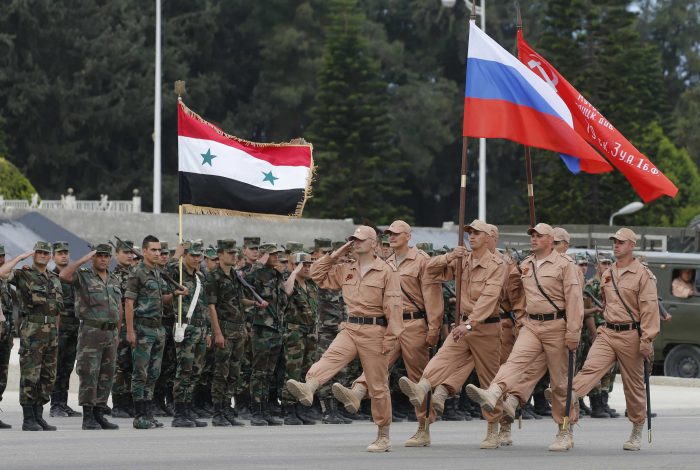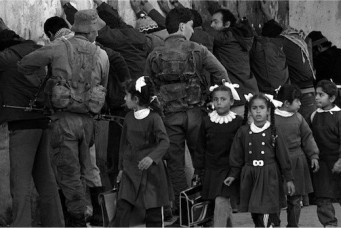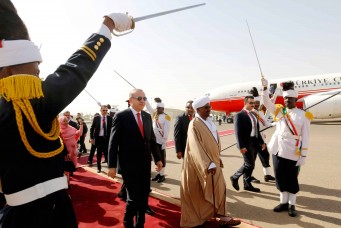End of War, but Not of Conflict
State (re)building in war-torn countries can only happen in a conducive political process on all levels ranging from the local to the international, which is exactly what seems lacking in MENA

Russian soldiers march before a Syrian unit during a Victory Day parade rehearsal at the Hmeymim airbase in Latakia, Syria, May 4, 2016. Sergei Chirikov/EFE/EPA
Although Arab nation states have been the sites of popular uprisings, civil wars, regime change and state collapse since the turn of the twenty-first century, developments within these states have been subject to a myriad of dynamics, actors and flows that emanated from beyond their borders. These included state and non-state, regional, as well as international forces which intervened militarily, diplomatically and economically with the aim of influencing, if not altogether shaping, the outcomes of processes on the national level. The relevance of this plethora of actors has grown with the typical weakening, if not the complete crippling, of central governments in the context of civil wars and their aftermath.
There is little doubt that long years of civil war, external military intervention and the full or partial collapse of central state apparatuses have created new realities on the ground, which will shape the prospect, extent and scale of any post-conflict recovery and reconstruction. The key question here is how these dynamics will contribute to cementing or altering war-created realities, be they economic, political or social in the war-ridden countries of Syria, Iraq, Libya and Yemen.
In pursuit of an answer, this essay adopts a geo-economic angle in which geopolitics combines with economics. Geo-economics as an analytical tool has referred either to the use of economic power to achieve geopolitical gains, or to economic consequences of the geopolitical shifts as expressed in global trade, protectionism and neo-mercantilism. This approach views post-conflict reconstruction as an inherently political-economic process that has clear power dynamics and implications rather than the simple physical rebuilding of whatever was destroyed during years of conflict. As an approach to the world economic system, geo-economics can provide an international dimension for ongoing civil wars and regional competition by considering geopolitical rivalries between powers such China and Russia and established powers with hegemonic legacies in the region such as the United States and Europe. We tend to believe that the Middle East and North Africa (MENA) region’s geo-economics may lead to ending civil wars but not necessarily the state of conflict. Most likely, there will not be a clear-cut post-conflict phase in any of the war-torn countries but rather conflicts of lower intensity marked by fewer occurrences of violence, but not its complete cessation. In other words, the post-conflict reconstruction in the four cases will be mainly shaped by the struggle over regional dominance and the interactions of the regional and international powers, and this struggle is fueled by the fluidity of the regional and international systems in the post¬hegemonic era.
International Dimensions of Domestic Conflicts
None of the regional and global dynamics that influenced or shaped the post¬2011 trajectories were altogether new. In fact, many of the actors, flows and patterns of interaction could be traced back to decades earlier. Indeed, MENA has historically been characterized by high levels of permeability through extensive intra-regional flows of people, ideas and capital as well as higher levels of penetration by external actors where no autonomous regional system ever existed without continuous confrontation with external actors.
Geo-economic dynamics in MENA have intensified civil conflict in war-torn countries since 2011. They have led to the rise of multiple regional rivalries. These include Saudi Arabia versus Iran; Qatar (allied to the Islamists) vs. the United Arab Emirates (UAE); Turkey vs. Egypt (in Libya); and Israel vs. Iran and Hezbollah in Syria. In turn, the uncertainties associated with a weakened role of the United States in the region have fed (so far) into proxy wars within war-torn countries instead of international conflict. These dynamics have led to the weakening of already fragile and contested national orders. Overall, they created incentives for competing regional and international powers to invest in the further weakening of central governments through direct military intervention, the support of anti- or pro-regime militias, and the promotion of cross-regional ethno-sectarian identities.
The way conflicts have evolved in the past eight years in MENA has led to the enforcement of many of the pre-2011 dynamics on the national level by exacerbating socio-political and economic exclusion and deepening already existing cross-regional senses of grievance. A key observation is the general lack of any functioning political systems nationally, regionally or globally, which raises the stakes and deepens the sense of insecurity and uncertainty.
This itself would feed into new rounds of, most probably less intensive but protracted and prolonged, conflict within these fragile states and the allocation of resources for further undermining of national orders in a myriad of ways.
The Ordeal of State (Re)building
In addition to the obvious socioeconomic damages on physical, human and social capital that ongoing wars have inflicted, there has also been considerable weakening of state institutions in war-torn countries, politically, financially and administratively. This is likely to persist for years after civil wars end. States won’t be capable of restoring their authority over all of their national territory because of the intensive involvement of external forces either directly through military occupation or indirectly through the support of local armed groups. This applies both to external allies as well as rivals. In Syria for instance, a Turkish or NATO presence in the northern parts of the country would detract directly from the administrative and military control of the regime, after the latter has achieved dominance over most of the Syrian territory with the military assistance and direct intervention of Russia and Iran. However, the same applies to the regime’s allies.
The Bashar Al-Assad regime will have to adapt to future plans for permanent and direct Russian and Iranian presence in the country rather than vice versa. De facto military occupation is hardly commensurate with sovereignty or autonomy of nation-states. Additionally, the near absence of any “all-inclusive” political process nationally, regionally or multilaterally will allow the scars of civil war and violence to linger and feed resentment against the re-imposition of state/regime authority.
A sustainable future stabilization of MENA will depend on state-(re)building in war-torn countries. Not only is this an imperative for enduring peace but also for attracting capital for reconstruction and the re-launching of the economy. This, however, requires the reversal of the concurrent intra-regional rivalry where powerful regional players have all the incentives to weaken state structures and institutions in war-torn countries. This exacerbates already troubled and incomplete processes of nation-state building in MENA, and especially in war-torn countries that were already prone to breakdown due to deep societal divisions, having fierce states that are captured by limited closely-knit groups and that have historically lacked successful construction of a national identity.
Part of the challenge in MENA is to change the incentive structure of rival regional (and international) powers so as to invest in state-making rather than unmaking. This, however, is something that goes far beyond the technical and financial focus of typical post-conflict reconstruction projects. Injecting funds into war-torn countries or rebuilding their destroyed physical capital does not make up a state. Funding reconstruction might be a helping, or even necessary, precondition but not a sufficient one.
This is the hard lesson learned from cases like Kosovo, East Timor, South Sudan, and the Democratic Republic of Congo where extensive international engagement in state-building has failed in pulling these societies out of what seems to be a permanent condition of fragility and an exacerbated rent-dependency. State (re)building in war-torn countries can only happen in a conducive political process on all levels ranging from the local to the international, which is exactly what seems lacking in MENA.
A Geo-economics of Recovery and Reconstruction in MENA
There is nothing inevitable, automatic or necessary in post-conflict reconstruction and recovery. It may take place or it may not. It may further consolidate the realities that war had created (e.g. authoritarian stabilization, further exclusion and marginalization of ethnic and religious groups, the de facto split of national territory etc.). Conversely, it may contribute to their altering with economic means pushing for reconciliation, state building and development. Our policy concern is that there are two major obstacles that may undermine how economics can push for a more sustainable reconstruction and recovery that would be conducive for reconciliation and peace in the long term.
On the one hand, international oil prices, the umbilical cord linking MENA to the world economy, are expected to remain below the 2014 range in the medium- to long-term. This would limit the amount of resources available for MENA as a whole and hence preclude or at least restrain future reconstruction and political stabilization. This would apply to both oil-rich as well as oil-poor war-torn countries given the complex and multiple mechanisms of oil-rent recycling that have characterized MENA’s geo-economics since the 1970s.
On the other hand, the absence of macro-security and political arrangements in MENA will likely render attempts at reconstruction and recovery extensions of regional and international rivalry. The way civil wars have either been brought to an end such as in Syria; to a stalemate such as in Yemen and recently Libya, has not involved any political process nationally, regionally or internationally. This situation will have grave consequences for the availability of resources in MENA generally and in war-torn countries more specifically. For instance, the European Union (EU) has made it clear that they won’t pitch in any resources to the reconstruction of Syria unless a political process is launched to integrate the opposition. Similarly, it is unlikely that the Gulf Cooperation Council (GCC) countries would offer aid, soft loans or investment from their sovereign funds or even politically-connected businesspeople for reconstruction in countries allied with their archenemy Iran.
It is also noteworthy that none of the post-conflict reconstruction processes will likely have a multilateral dynamic, most prominently through the UN. Contrary to earlier cases like Kosovo, the Democratic Republic of Congo, East Timor, and South Sudan, the UN has no direct presence on the ground in the form of peacekeeping missions in any of the four war-torn countries in MENA. Moreover, international rivalry between the United States and Russia (and to a lesser extent China) has limited the role the Security Council could play with regard to the conflict in Syria.
Moreover, private investment by foreigners or nationals in a post-conflict context will depend on political variables like enduring peace and security, the protection of private property from predation by corrupt officials or local militiamen, and the guarantees and incentives offered by host governments.
The primacy of politics in post-conflict reconstruction shows itself forcefully also in oil-rich war-torn countries such as Iraq that won’t likely rely as extensively on external funding. The case of post-2003 Iraq reveals that access to large oil revenues was by no means enough for either recovery and reconstruction or reconciliation and stabilization. Many depicted a grim picture of how rampant corruption, state capture by powerful political parties—usually affiliated with armed groups—and deep ethno-sectarian divides derailed recovery and could not stop falling prey to an extended insurgency and a devastating civil war (2006–2008). Large oil revenues flowing to the Iraqi central government did not translate into nation-building such as founding a professional army, better public services or more efficient institutions.
Post-Qaddafi’s Libya is another case in point. Once again, access to oil revenue, the control over oil fields and relevant infrastructure for exporting it like ports and roads, have proven to be bones of contention between warring parties rather than an enabling factor for agreement or reconciliation. Additionally, both countries despite their national riches remain heavily penetrated by foreign actors that wield enough power to influence, if not altogether reshape, political processes on the local and national levels.
End of War is Not the End of Conflict
War-torn countries will most likely remain whole but hollow. States will be kept together in one piece, at least formally in the eyes of international law and international organizations. This was demonstrated in the international and regional consensus against Kurdish independence in Iraq following the referendum of September 2017. It was also manifested in the wiping out of the Islamic State in Iraq and Syria (ISIS) and its self-proclaimed caliphate in those countries. It is equally unlikely that regional or international powers would welcome the formal partition of existing failed states, be it in Southern Yemen or the partitioning of Libya or Syria. Likewise, there won’t be any formalization of de-facto annexation of territory as with Turkish-occupied northern Syria. Post-conflict states will, however, be hollow structures with remarkably diminished administrative capacities to practice sovereignty over their economies (for example, rampant informality, including cross-border smuggling and human trafficking and other remnants of war economy), social relations (for example, widespread violence and crime), or the totality of their territories (for example, organized crime, armed local militias functioning as intermediaries with the central government or foreign occupation forces, sometimes with the government’s consent).
With the continuation of international and regional rivalries amid the absence of political processes in war-torn countries (again with the possible exception of Iraq), economic resources will be flowing according to shorter term considerations of relief, refugee, and internally displaced people’s return. This will likely correspond to the entrenchment and enforcement of unilateral arrangements but not long-term arrangements on the national level, risking the reproduction and perpetuation of the same grievances and roots for possible further rounds of conflict, likely supported by rival powers.
Given the above, it may be safe to state that reconstruction in MENA, or attempts at it at least, will not necessarily happen after the fires of war have been completely extinguished. There is a possibility that they may proceed in less certain contexts with a higher tolerance for low-intensity violence that is short of full-fledged war. Post-ISIS Iraq fits well into this. Cities and towns of northwestern Iraq are expected to be rebuilt and refugees and internally displaced people return regardless of continued terrorist threats or the absence of a grand socio-political pact that would ensure the re-integration of Sunni Arabs. The same may apply to Libya, which has progressively witnessed the consolidation of a de facto partition between the east and the west. With two governments, two parliaments, two central banks and two national oil authorities, there may be partial attempts at reconstruction, especially in the east. Needless to say, this will likely be the case in Syria once the regime and its Russian and Iranian allies regain control over all national territory, or most of it.
Reconstruction attempts may also be used strategically by regional and international powers for the de facto annexation or partition of territories in war-torn countries. There are a number of potential cases in MENA, such as evidence of attempts by the Turkish government to fix some infrastructure and restoring public services in the northern part of Syria where Ankara is maintaining a military presence. In a similar vein, the U.S.-led coalition in Syria may play the reconstruction card with the predominantly Kurdish People’s Protection Units (YPG) for any future plans for a longer-term presence. Southern Yemen also might be the scene for a Saudi- or more probably a UAE-sponsored reconstruction in a de facto partition of the country as a longer-term strategy against a Houthi-dominated north, within the framework of a loosely unified Yemen.
The challenge to post-conflict reconstruction in MENA can only be tackled through politics as we have previously highlighted. Reconstruction in the absence of political processes means a continuation of conflict by other means. It will not contribute to longer-term hopes of stabilization. What the region needs is reconstruction that allows a political reconstitution of war-torn states and societies. This can only happen through pan-regional security and cooperation arrangements which in turn require the presence of political processes on the regional and national levels.
Whereas reconciliation or peacebuilding on the national and local levels are often complex and subject to dynamics that are relatively autonomous of external factors and processes, regional and international actors and flows can exacerbate or mitigate post-conflict domestic circumstances. This applies to all four cases, Syria, Iraq, Libya, and Yemen to varying degrees. The critical linkage is hence reaching some kind of a regional security arrangement between major rivals, namely Saudi Arabia, Iran, and Turkey in the Middle East, and Egypt in the case of Libya. This of course cannot occur without a strong role played by the United States and Russia, given the high levels of external penetration MENA has always exhibited. If the realities created by eight years of war—with a considerable degree of foreign military, economic and diplomatic involvement—form the basis for a sustainable and long-term security arrangement, then a geopolitical base for reconstruction and recovery may actually take root.
Subscribe to Our Newsletter




